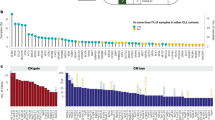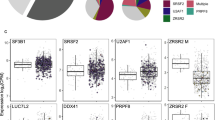Abstract
Here we perform whole-exome sequencing of samples from 105 individuals with chronic lymphocytic leukemia (CLL)1,2, the most frequent leukemia in adults in Western countries. We found 1,246 somatic mutations potentially affecting gene function and identified 78 genes with predicted functional alterations in more than one tumor sample. Among these genes, SF3B1, encoding a subunit of the spliceosomal U2 small nuclear ribonucleoprotein (snRNP), is somatically mutated in 9.7% of affected individuals. Further analysis in 279 individuals with CLL showed that SF3B1 mutations were associated with faster disease progression and poor overall survival. This work provides the first comprehensive catalog of somatic mutations in CLL with relevant clinical correlates and defines a large set of new genes that may drive the development of this common form of leukemia. The results reinforce the idea that targeting several well-known genetic pathways, including mRNA splicing, could be useful in the treatment of CLL and other malignancies.
This is a preview of subscription content, access via your institution
Access options
Subscribe to this journal
Receive 12 print issues and online access
$209.00 per year
only $17.42 per issue
Buy this article
- Purchase on Springer Link
- Instant access to full article PDF
Prices may be subject to local taxes which are calculated during checkout




Similar content being viewed by others
References
Rozman, C. & Montserrat, E. Chronic lymphocytic leukemia. N. Engl. J. Med. 333, 1052–1057 (1995).
Zenz, T., Mertens, D., Kuppers, R., Dohner, H. & Stilgenbauer, S. From pathogenesis to treatment of chronic lymphocytic leukaemia. Nat. Rev. Cancer 10, 37–50 (2010).
Damle, R.N. et al. Ig V gene mutation status and CD38 expression as novel prognostic indicators in chronic lymphocytic leukemia. Blood 94, 1840–1847 (1999).
Hamblin, T.J., Davis, Z., Gardiner, A., Oscier, D.G. & Stevenson, F.K. Unmutated Ig VH genes are associated with a more aggressive form of chronic lymphocytic leukemia. Blood 94, 1848–1854 (1999).
Puente, X.S. et al. Whole-genome sequencing identifies recurrent mutations in chronic lymphocytic leukaemia. Nature 475, 101–105 (2011).
Greenman, C. et al. Patterns of somatic mutation in human cancer genomes. Nature 446, 153–158 (2007).
Pleasance, E.D. et al. A comprehensive catalogue of somatic mutations from a human cancer genome. Nature 463, 191–196 (2010).
Pleasance, E.D. et al. A small-cell lung cancer genome with complex signatures of tobacco exposure. Nature 463, 184–190 (2010).
Greif, P.A. et al. Identification of recurring tumor-specific somatic mutations in acute myeloid leukemia by transcriptome sequencing. Leukemia 25, 821–827 (2011).
Chapman, M.A. et al. Initial genome sequencing and analysis of multiple myeloma. Nature 471, 467–472 (2011).
Wahl, M.C., Will, C.L. & Luhrmann, R. The spliceosome: design principles of a dynamic RNP machine. Cell 136, 701–718 (2009).
Wang, H., Nora, G.J., Ghodke, H. & Opresko, P.L. Single molecule studies of physiologically relevant telomeric tails reveal POT1 mechanism for promoting G-quadruplex unfolding. J. Biol. Chem. 286, 7479–7489 (2011).
Marfella, C.G. & Imbalzano, A.N. The Chd family of chromatin remodelers. Mutat. Res. 618, 30–40 (2007).
Prazeres, H. et al. Chromosomal, epigenetic and microRNA-mediated inactivation of LRP1B, a modulator of the extracellular environment of thyroid cancer cells. Oncogene 30, 1302–1317 (2011).
Tiacci, E. et al. BRAF mutations in hairy-cell leukemia. N. Engl. J. Med. 364, 2305–2315 (2011).
Zhang, X. et al. Sequence analysis of 515 kinase genes in chronic lymphocytic leukemia. Leukemia published online (24 June 2011), doi:10.1038/leu.2011.163.
Zainuddin, N. et al. TP53 mutations are infrequent in newly diagnosed chronic lymphocytic leukemia. Leuk. Res. 35, 272–274 (2011).
Fabbri, G. et al. Analysis of the chronic lymphocytic leukemia coding genome: role of NOTCH1 mutational activation. J. Exp. Med. 208, 1389–1401 (2011).
Folco, E.G., Coil, K.E. & Reed, R. The anti-tumor drug E7107 reveals an essential role for SF3b in remodeling U2 snRNP to expose the branch point-binding region. Genes Dev. 25, 440–444 (2011).
Corrionero, A., Minana, B. & Valcarcel, J. Reduced fidelity of branch point recognition and alternative splicing induced by the anti-tumor drug spliceostatin A. Genes Dev. 25, 445–459 (2011).
Golas, M.M., Sander, B., Will, C.L., Luhrmann, R. & Stark, H. Molecular architecture of the multiprotein splicing factor SF3b. Science 300, 980–984 (2003).
David, C.J. & Manley, J.L. Alternative pre-mRNA splicing regulation in cancer: pathways and programs unhinged. Genes Dev. 24, 2343–2364 (2010).
Karni, R. et al. The gene encoding the splicing factor SF2/ASF is a proto-oncogene. Nat. Struct. Mol. Biol. 14, 185–193 (2007).
Golan-Gerstl, R. et al. Splicing factor hnRNP A2/B1 regulates tumor suppressor gene splicing and is an oncogenic driver in glioblastoma. Cancer Res. 71, 4464–4472 (2011).
Kaida, D. et al. Spliceostatin A targets SF3b and inhibits both splicing and nuclear retention of pre-mRNA. Nat. Chem. Biol. 3, 576–583 (2007).
Yoshida, K. et al. Frequent pathway mutations of splicing machinery in myelodysplasia. Nature 478, 64–69 (2011).
Papaemmanuil, E. et al. Somatic SF3B1 mutation in myelodysplasia with ring sideroblasts. N. Engl. J. Med. 365, 1384–1395 (2011).
Visconte, V. et al. SF3B1, a splicing factor is frequently mutated in refractory anemia with ring sideroblasts. Leukemia published online (2 September 2011), doi:10.1038/leu.2011.232.
Chen, A.A. et al. Genetic variation in the vitamin C transporter, SLC23A2, modifies the risk of HPV16-associated head and neck cancer. Carcinogenesis 30, 977–981 (2009).
Bulwin, G.C. et al. TIRC7 inhibits T cell proliferation by modulation of CTLA-4 expression. J. Immunol. 177, 6833–6841 (2006).
Brown, P.J. et al. Potentially oncogenic B-cell activation–induced smaller isoforms of FOXP1 are highly expressed in the activated B cell–like subtype of DLBCL. Blood 111, 2816–2824 (2008).
Hudson, T.J. et al. International network of cancer genome projects. Nature 464, 993–998 (2010).
Bentley, D.R. et al. Accurate whole human genome sequencing using reversible terminator chemistry. Nature 456, 53–59 (2008).
Trapnell, C., Pachter, L. & Salzberg, S.L. TopHat: discovering splice junctions with RNA-Seq. Bioinformatics 25, 1105–1111 (2009).
Li, H. & Durbin, R. Fast and accurate short read alignment with Burrows-Wheeler transform. Bioinformatics 25, 1754–1760 (2009).
Li, H. et al. The Sequence Alignment/Map format and SAMtools. Bioinformatics 25, 2078–2079 (2009).
Baudot, A., de la Torre, V. & Valencia, A. Mutated genes, pathways and processes in tumours. EMBO Rep. 11, 805–810 (2010).
Kanehisa, M., Goto, S., Furumichi, M., Tanabe, M. & Hirakawa, M. KEGG for representation and analysis of molecular networks involving diseases and drugs. Nucleic Acids Res. 38, D355–D360 (2010).
Schaefer, C.F. et al. PID: the Pathway Interaction Database. Nucleic Acids Res. 37, D674–D679 (2009).
Ashburner, M. et al. Gene ontology: tool for the unification of biology. The Gene Ontology Consortium. Nat. Genet. 25, 25–29 (2000).
Reva, B., Antipin, Y. & Sander, C. Predicting the functional impact of protein mutations: application to cancer genomics. Nucleic Acids Res. 39, e118 (2011).
Wu, S. & Zhang, Y. MUSTER: improving protein sequence profile-profile alignments by using multiple sources of structure information. Proteins 72, 547–556 (2008).
Peto, R. & Pike, M.C. Conservatism of the approximation sigma (O-E)2-E in the logrank test for survival data or tumor incidence data. Biometrics 29, 579–584 (1973).
Acknowledgements
We are grateful to P. Klatt for continuous support, E. Montserrat, J. Valcárcel, P. Nicolás and C. Romeo-Casabona for helpful comments, S. Guijarro, S. Martín, C. Capdevila, M. Sánchez and L. Plá for excellent technical assistance, and N. Villahoz and C. Muro for excellent work in the coordination of the CLL Spanish Consortium. We are also very grateful to all the individuals with CLL who participated in this study. This work was funded by the Spanish Ministry of Science and Innovation (MICINN) through the Instituto de Salud Carlos III (ISCIII) and Red Temática de Investigación del Cáncer (RTICC) del ISCIII. C.L-O. is an Investigator of the Botín Foundation.
Author information
Authors and Affiliations
Contributions
V.Q., G.R.O., A.J.R., G.V., J.M.P.F. and X.S.P. developed the bioinformatic algorithms and performed the analysis of sequence data. L.C., P.J., M.P., M.L.-G., D.C. and A.N. were responsible for downstream validation analysis and functional studies. L.B., S.B. and J.M.C.T. studied structural variants. D.A.P., H.H., M.B., S.H. and M.G. were responsible for generating libraries, performing exome capture and running sequencers. M.A. prepared and supervised the bioethics requirements. N.V., A.M.-T., T.B., J.D., E.G., A.L.-G. and E.C. performed clinical and biological studies. M.R., M.G.-D., N.V. and J.M.H. reviewed the pathologic data and confirmed the diagnosis. R.R., J.L.G., M.O., D.G.P., J.Z., M.V. and A.V. were in charge of bioinformatics data management. I.G. coordinated the sequencing efforts and performed primary data analysis. V.Q., X.S.P., X.E., A. L.-G., E.C. and C.L.-O. directed the research and wrote the manuscript, which all authors have approved.
Corresponding authors
Ethics declarations
Competing interests
The authors declare no competing financial interests.
Supplementary information
Supplementary Text and Figures
Supplementary Note, Supplementary Figures 1–3 and Supplementary Tables 1–3 and 5–16 (PDF 634 kb)
Supplementary Table 4
Somatic mutations in CLL patients (XLSX 193 kb)
Rights and permissions
About this article
Cite this article
Quesada, V., Conde, L., Villamor, N. et al. Exome sequencing identifies recurrent mutations of the splicing factor SF3B1 gene in chronic lymphocytic leukemia. Nat Genet 44, 47–52 (2012). https://doi.org/10.1038/ng.1032
Received:
Accepted:
Published:
Issue Date:
DOI: https://doi.org/10.1038/ng.1032
This article is cited by
-
Targeting Pim kinases in hematological cancers: molecular and clinical review
Molecular Cancer (2023)
-
FUS-ERG induces late-onset azacitidine resistance in acute myeloid leukaemia cells
Scientific Reports (2023)
-
Different prognostic impact of recurrent gene mutations in chronic lymphocytic leukemia depending on IGHV gene somatic hypermutation status: a study by ERIC in HARMONY
Leukemia (2023)
-
Multi-omics reveals mitochondrial metabolism proteins susceptible for drug discovery in AML
Leukemia (2022)
-
Emerging roles of spliceosome in cancer and immunity
Protein & Cell (2022)



